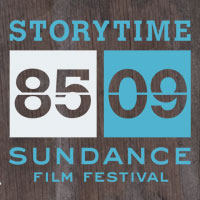Today is the last day of this year’s Sundance Film Festival, the theme of which is “Storytime.” Although Storytime seems to be more about “the stories — from the screen and from the street — that make Sundance what it is” than about storytelling in films per se, Michelle Meyers, writing on CNET, notes that “the theme … is … apropos considering stories are the heart of each and every film.” She points out the festival’s New Frontier programming category “featuring films that challenge conventional form. Among these is “We Feel Fine,” which I blogged about (sort of) here. As Meyers describes it, In We Feel Fine, programmers Jonathan Harris and Sep Kamvar have created a program that “takes sentences every few minutes from recently published blogs from around the world that include the words ‘I feel’ or ‘I am feeling’ and visualizes them in six different movements.”
Whether Sundance’s Storytime theme is more suggestive of storytelling in  films or narrative about the festival itself, it conveys an optimism about the future of storytelling in film — and in forms (like “We Feel Fine”) closely related to film.
films or narrative about the festival itself, it conveys an optimism about the future of storytelling in film — and in forms (like “We Feel Fine”) closely related to film.
Seemingly not so MIT’s Media Lab (in conjunction with Plymouth Rock Studios), which late last year established The Center for Future Storytelling. In counterpoint to Sundance’s hopeful view of storytelling’s future, the center was founded “out of concern that text messages, cell phones and the constant bombardment of visual chatter and changing the integrity of narrative” and “to keep meaning alive in 21st-century storytelling,” according to Sally Mendzela of Queen of the Playground.
Harkening back to my post yesterday about open-loop storytelling, the center will look at “whether the old way of telling stories — particularly those delivered to the millions on screen, with a beginning, a middle and an end — is in serious trouble,” reports Michael Cieply in the New York Times. Open-ended videogames and film series such as Pirates of the Caribbean and Spider Man seem to be a concern, according to Cieply.
The MIT folks refer to 21st-century storytelling, raising questions about what 21st-century storytelling is. Is it one thing? Is it many things?
Cieply cites film producer and former studio head Peter Guber as worrying that “traditional narrative … has been drowned out by noise and visual clutter” and blames audiences “for the perceived breakdown in narrative quality.”
Coming full circle back to Sundance, I disagree with Guber and agree with the view of Sundance Institute’s Executive Director Ken Brecher, whom Cieply interviewed: “Storytelling is flourishing in the world at a level I can’t even begin to understand,” Cieply quotes Brecher as saying. Cieply also reports Brecher’s view that “technology has simply brought mass storytelling, on film or otherwise, to people who once thought Hollywood had cornered the business.”
You bet storytelling is flourishing! I see that every day as I investigate the story work for this blog.
It’s quite possible, though, that the role of the Center for Future Storytelling has been misunderstood. Indeed, as I read the original press release that MIT issued, I saw no dire concerns about information overload, noise, and clutter. Instead, I saw a vision that actually seems to align with Sundance’s hopeful view of storytelling:
… the [MIT] Media Lab and Plymouth Rock Studios will collaborate revolutionize how we tell our stories, from major motion pictures to peer-to-peer multimedia sharing. By applying leading-edge technologies to make stories more interactive, improvisational and social, researchers will seek to transform audiences into active participants in the storytelling process, bridging the real and virtual worlds, and allowing everyone to make their own unique stories with user-generated content on the Web.
And the release quotes Frank Moss, Media Lab director and holder of the Jerome Wiesner Professorship of Media Arts and Sciences, as saying:
[Storytelling] is how we share our experiences, learn from our past, and imagine our future. But how we tell our stories depends on another uniquely human characteristic — our ability to invent and harness technology. From the printing press to the Internet, technology has given people new ways to tell their stories, allowing them to reach new levels of creativity and personal fulfillment. The shared vision of the MIT Media Lab and Plymouth Rock Studios allows us to take the next quantum leap in storytelling, empowering ordinary people to connect in extraordinary ways.
Indeed, Rich Kearney, one of the Plymouth Rock Studios folks managing the new center responded to Sally Mendzela’s post with this (run-on sentence) refutation:
… we’re not against new technologies that fragment the audience, one of our main goals is to harness new media to bring storytelling to new heights.
I do not believe storytelling in the 21st century is in trouble. I do believe it is changing, and new forms are evolving. It may be worth asking, however, if stories are losing their meaning when told in some of these new, open-loop forms.
